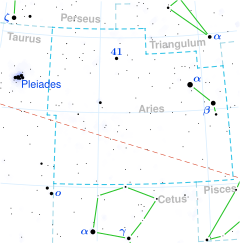아리에티스 요타
Iota Arietis| 관측 데이터 신기루 J2000.0 이쿼녹스 J2000.0 | |
|---|---|
| 별자리 | 양자리 |
| 우측 상승 | 01h 57m 21.05476s[1] |
| 탈위임 | +17° 49′ 03.1202″[1] |
| 겉보기 크기 (V) | 5.117[2] |
| 특성. | |
| 스펙트럼형 | K1p[3] 또는 G8III[4] |
| U-B색지수 | +0.700[2] |
| B-V색지수 | +0.921[2] |
| 아스트로메트리 | |
| 방사 속도 (Rv) | -4.9km[5]/s |
| 고유 운동 (μ) | RA: +34.76[1]mas/yr Dec.: −22.95[1]mas/yr |
| 시차 (π) | 6.27 ± 0.33[1] mas |
| 거리 | 520 ± 30 리 (105 ± 8pc) |
| 절대치수 (MV) | −0.4[6] |
| 궤도[7] | |
| 기간 (P) | 1,567.66±0.62 d |
| 반주축 (a) | ≥ 217 gm(1.45AU) |
| 편심성 (e) | 0.356±0.022 |
| 페리아스트론 신기원을 이루다 (T) | 2,420,961.1±27.2 JD |
| 페리아스트론의 인수 (ω) (2차) | 94.04±4.72° |
| 반암도 (K1) (iii) | 10.78±0.31km/s |
| 세부 사항 | |
| 미사 | 3.17[8] M☉ |
| 반지름 | 20[8] R☉ |
| 루미도 | 240[8] L☉ |
| 표면 중력 (log g) | 2.60[9] cgs |
| 온도 | 5,031[8] K |
| 금속성 [Fe/H] | -0.10[9] 덱스 |
| 회전 속도 (v sin i) | 3.33km[9]/s |
| 기타 지정 | |
| 데이터베이스 참조 | |
| 심바드 | 자료 |
ι 아리에티스(Arietis)에서 라틴어로 표기된 이오타 아리에티스(Yoota Arietis)는 북양자리 별자리의 바이너리 항성계통(Bayer)의 명칭이다.그것은 겉보기에는 5.117의 시각적 크기를 가지고 있는데,[2] 육안으로 희미하게 보일 정도로 밝다.히파르코스 임무 동안 행해진 시차 측정은 지구로부터 520광년(160파섹)의 추정 거리를 산출한다.[1]이 시스템의 가변 방사 속도는 1922년 W. W. 캠벨에 의해 발표되었다.K. C. 고든은 1946년에 이 단일선 분광형 이항체계에 대한 궤도 원소를 발표하여 궤도 주기는 4.29년, 편심(오발성)은 0.36년이었다.[7]
가시적 구성요소의 경우, 1952년 N. G. Roman은 K1p의 별 분류를 발견했는데, 여기서 'p'는 스펙트럼에 대한 어떤 유형의 특이성을 나타낸다.그녀의 논평은 "수소선과 λ 4290은 Ⅱ급 별을 나타낼 만큼 강하지만 CN은 Ⅲ급에 겨우 강하며, sr II는 이에 필요한 것보다 강하지 않다"고 지적했다.[3]E. A. Harlan은 1969년에 "Δ strong, Fe I is4045는 활자에 약하다"는 논평을 내고 K 특이 등급을 발표했다.[11]1990년 K.사토와 S.쿠지는 G8 수업을 했다.III, 이것이 노후화된 G형 거성임을 시사하며 그 독특한 위상에 의문을 제기한다.[4]별의 성질에 대한 베이지안 추론은 이 별이 수평 가지에 있다는 것을 나타낸다.[8]그 동반자는 백색 왜성으로 의심되는 사람이다.[12]
참조
- ^ a b c d e f van Leeuwen, F. (November 2007), "Validation of the new Hipparcos reduction", Astronomy and Astrophysics, 474 (2): 653–664, arXiv:0708.1752, Bibcode:2007A&A...474..653V, doi:10.1051/0004-6361:20078357, S2CID 18759600.
- ^ a b c d Jennens, P. A.; Helfer, H. L. (September 1975), "A new photometric metal abundance and luminosity calibration for field G and K giants.", Monthly Notices of the Royal Astronomical Society, 172 (3): 667–679, Bibcode:1975MNRAS.172..667J, doi:10.1093/mnras/172.3.667.
- ^ a b Roman, Nancy G. (July 1952), "The Spectra of the Bright Stars of Types F5-K5", Astrophysical Journal, 116: 122, Bibcode:1952ApJ...116..122R, doi:10.1086/145598.
- ^ a b Sato, K.; Kuji, S. (1990), "MK classification and photometry of stars used for time and latitude observations at Mizusawa and Washington", Astronomy and Astrophysics Supplement Series, 85: 1069, Bibcode:1990A&AS...85.1069S.
- ^ Wilson, Ralph Elmer (1953), "General Catalogue of Stellar Radial Velocities", Carnegie Institute Washington D.C. Publication, Washington: Carnegie Institution of Washington, Bibcode:1953GCRV..C......0W.
- ^ Helfer, H. L.; Wallerstein, George (August 1968), "Abundances in K-Giant Stars. II. a Survey of Field Stars", Astrophysical Journal Supplement, 16: 1, Bibcode:1968ApJS...16....1H, doi:10.1086/190169.
- ^ a b Gordon, Katherine C. (1946), "The Spectroscopic Orbit of ι ARIETIS", The Astrophysical Journal, 103: 16–18, Bibcode:1946ApJ...103...16G, doi:10.1086/144784.
- ^ a b c d e Stock, Stephan; et al. (August 2018), "Precise radial velocities of giant stars. X. Bayesian stellar parameters and evolutionary stages for 372 giant stars from the Lick planet search", Astronomy & Astrophysics, 616: 15, arXiv:1805.04094, Bibcode:2018A&A...616A..33S, doi:10.1051/0004-6361/201833111, S2CID 119361866, A33.
- ^ a b c Hekker, S.; Meléndez, J. (2007), "Precise radial velocities of giant stars. III. Spectroscopic stellar parameters", Astronomy and Astrophysics, 475 (3): 1003–1009, arXiv:0709.1145, Bibcode:2007A&A...475.1003H, doi:10.1051/0004-6361:20078233, S2CID 10436552.
- ^ "* iot Ari", SIMBAD, Centre de données astronomiques de Strasbourg, retrieved 2012-08-04.
- ^ Harlan, E. A. (September 1969), "MK classifications for F- and G-type stars. I", Astronomical Journal, 74: 916, Bibcode:1969AJ.....74..916H, doi:10.1086/110881.
- ^ Eggleton, P. P.; Tokovinin, A. A. (September 2008), "A catalogue of multiplicity among bright stellar systems", Monthly Notices of the Royal Astronomical Society, 389 (2): 869–879, arXiv:0806.2878, Bibcode:2008MNRAS.389..869E, doi:10.1111/j.1365-2966.2008.13596.x, S2CID 14878976.



